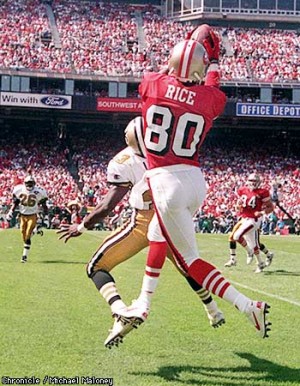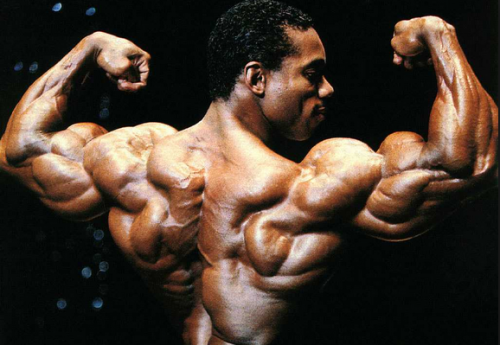“When you’re talking about the training of athletes, the fitness industry can be a very strange place. On one side, you have a lot of people making a lot of noise about how athletes should be trained and treated—and as it turns out, most of these people don’t actually train any athletes, and they never have. On the other side, you’ve got the insiders—guys who, without fanfare or self-promotion, quietly make names for themselves making the best athletes in the world even better. Monte Spicer is the ultimate insider. He’s the ‘secret weapon’ of athletes all over the world, and he’s an awesome addition to the DH team.” – Kiefer
DH: For everyone who hasn’t yet listened to your BioJacked interview, introduce yourself to our audience and tell us a little about what you do.
Monte Spicer: I’m the owner of Kinetic Chain Sport in Pleasanton, CA. I specialize in sports therapy, which entails different things including strength and conditioning training, speed, agility, and recovery, which is tissue work dealing with the kinetic chain. This speeds up the process of recovery. When you train, you need something that’s going to help your body recover, and the type of therapy we do accomplishes that. It’s specifically designed for athletes who train hard and need that extra edge with recovery.
My background is in exercise physiology. I’ve worked with hundreds of NFL players, major league baseball players, and everyday people. What I do deals with the gait and the chain. We can watch somebody walk or run and tell what muscles aren’t firing, and then activate those muscles—and even go further with that and speed up recovery. There are so many different injuries that mimic different things. You could have a hip injury, and it’ll mimic your ACL, or you could have a foot injury, and it’ll be like your lower back is screwed up. We specialize in fixing that.
DH: What’s the deal with all the athletes who come to see you?
Monte Spicer: They’ll come in and we’ll do their recovery work. I have local guys with the Raiders and the 49ers that come in, and I’ll also fly to Utah and work with a lot of guys. I work with several different agents who’ll have guys getting ready for the NFL Combine, and some of them will have issues where they can’t figure out what’s wrong, so we’ll work on them. With athletes, doing it on a referral basis seems to work a lot better. With the internet and the website, you don’t get that much, because there’s a deeper bond with pro athletes where they’re like, “Hey, text this guy,” or, “Hey, call this guy.” If you look at our website, you won’t know who we really work with. We keep that kind of hush-hush.
DH: Why is that?
Monte Spicer: In the NFL, they’ll hire us individually. That way, if they’re all dinged up, if they have a hamstring that’s bothering them, every time they go to the trainer, the trainer marks it down on their medical file. Then, when it’s time to renegotiate a contract, they’re like, “Hey, you had that hamstring problem.” Now, they go see people like us. We keep them out of the training room, which keeps their value up a lot more, which allows them to get paid the next year—to get that contract they want.
DH: You’ve been doing this for a while now. What’s your impression of today’s professional athlete?
 Monte Spicer: I see some differences. The athletes of today aren’t as hungry for or knowledgeable about the work we do for them as the older guys were—like Jerry Rice, Rod Woodson, Bill Romanowski, and Charlie Garner. Those guys all played the game to its fullest, and they respect the work. They knew what it took to actually get the job done day after day. These new guys are better athletes, but they’re generally not as knowledgeable as far as taking care of their bodies, and recovery and nutrition—and that’s the biggest part of it. If you don’t have the nutrition and the recovery, I don’t care how good you are, you’re gonna hit a wall sooner or later. And when you hit that wall, you’re gonna hit it hard.
Monte Spicer: I see some differences. The athletes of today aren’t as hungry for or knowledgeable about the work we do for them as the older guys were—like Jerry Rice, Rod Woodson, Bill Romanowski, and Charlie Garner. Those guys all played the game to its fullest, and they respect the work. They knew what it took to actually get the job done day after day. These new guys are better athletes, but they’re generally not as knowledgeable as far as taking care of their bodies, and recovery and nutrition—and that’s the biggest part of it. If you don’t have the nutrition and the recovery, I don’t care how good you are, you’re gonna hit a wall sooner or later. And when you hit that wall, you’re gonna hit it hard.
DH: How’d you get your start with all of this?
Monte Spicer: I started doing basic massage back in ’91 or ’92, and I always wanted to work with athletes, so I started reading and going to seminars and studying different things. I knew there was something to it, because I met this guy when I used to compete in bodybuilding. I hurt my knee, and I swear it felt like it was my meniscus or something. It was messed up. I went to this guy out here in California, and I never experienced anything like it. I’m somebody who was squatting with five plates on each side for tons of reps, and when I was hurt, I could barely do 225 for three. So after I see him, I go back in the gym and my muscles were activated and I started coming back. I was like, “What did he do?”
DH: So what was it?
Monte Spicer: It was massage. Sports massage, and he just had that gift. A lot of therapists out there don’t have that gift. That touch. They don’t touch with intent. Some people just touch, and they don’t know what they’re doing. The don’t know how the muscles fire. They don’t know the sequence of the muscles. They’re not athletes working on athletes.
DH: What happened next?
 Monte Spicer: I was determined to go further with it. I had my office in Burlingame, because a lot of athletes would be over there, so I marketed myself there—and then I started getting all these different guys in. People started talking, and they started coming in. My big break was in 2001. I used to work with Bill Romanowski when he was with the Denver Broncos. He was a big believer in treatment and tissue work, and he said to me one day, “You know, you’re good. Do you want any more clients? I can make you as busy as you want to be.” That was it. That same year, the Raiders went to the Super Bowl, I went to the Pro Bowl—I had guys all over the place. I worked with some guys from the Carolina Panthers, and it was all like a dream come true.
Monte Spicer: I was determined to go further with it. I had my office in Burlingame, because a lot of athletes would be over there, so I marketed myself there—and then I started getting all these different guys in. People started talking, and they started coming in. My big break was in 2001. I used to work with Bill Romanowski when he was with the Denver Broncos. He was a big believer in treatment and tissue work, and he said to me one day, “You know, you’re good. Do you want any more clients? I can make you as busy as you want to be.” That was it. That same year, the Raiders went to the Super Bowl, I went to the Pro Bowl—I had guys all over the place. I worked with some guys from the Carolina Panthers, and it was all like a dream come true.
DH: How did that progress into what you have going now?
Monte Spicer: Once they started collective bargaining and renegotiation where the guys didn’t have to practice as much, it wasn’t so bad, but we used to do training camps. The Raiders and the 49ers, individual guys from both of those teams would hire me. My business partner would go to the 49ers, and I’d go to the Raiders, and then sometimes we would switch. The players would hire us because they had to get through camp. Now, they don’t have those rigorous training camps, but these guys still go into the season not engaging all their muscles and firing like they should. That’s why you see a lot of these hamstring pulls and lower back problems. A lot of these injuries can be prevented if they get the right type of work done. We do a lot of stuff when we work on them, all legal, to increase their vasodilation, increase their red blood cells, and increase oxygen flow through the tissue. The more oxygen flows through the tissue, the more it’s going to recover. It’s going to be more supple.
DH: Do you do any actual personal training and coaching?
Monte Spicer: Oh yeah, I do a lot of it. I pick and choose who I want to train, because to me, if I’m giving my time to somebody, I don’t want my time to be wasted, because I’ll never get it back. I like to work with people who are very intense, who are serious about their training—or people who have injuries, and I’ll bring them back to their strength levels. I can’t work with somebody who needs a cheerleader there all day, that needs somebody to talk to. I’ve done that. I won’t do it.
DH: What’s your facility like?
Monte Spicer: It’s 12,000 square feet, so we have 40 yards of indoor turf where we can do sled work, agility work, and speed work. On our weight floor, we have power racks, dumbbells up to 200 pounds, and kettlebells up to 150 pounds. Our facility can serve any type of lifter, and that’s what we want. We don’t want to cater to just one type. Anybody can come work out, but it’s a private facility where if somebody comes to town and doesn’t want to be bothered, that’s the place to train.
DH: What’s your philosophy when you work with training clients?
Monte Spicer: We always have a consultation with them first. When you’re a trainer, you’re always having some kind of relationship with your client, so it’s very important that your personalities mesh. There have been a few times where I thought I was going to work with someone, but their goals and what I wanted really didn’t match, so we had to hook them up with other trainers we have here. It’s important, because when you think about it, you’re spending an hour, four days a week, with this person for however long they sign up for, so there has to be some type of relationship and respect. If not, you’re gonna waste their time, and they’re not gonna get results.
DH: Your bodybuilding history is pretty extensive. Tell us some things about that.
 Monte Spicer: Bodybuilding was kind of like my vision on everything in life. I always want to be the best at what I do. I started working out when I was 13, and when I graduated from high school, I could bench press over 400 pounds, weighing 195. Muscle came really easy for me. Later on, I was down in LA and ran into Shawn Ray, who was a buddy of mine, and Charles Glass. They were like, “You should compete. You could make money at it.” So, I started taking it seriously. I would drive from northern California to southern California every two weeks just to go train in Venice, because I knew the best of the best were there—and if you wanted to be the best, you had to be around the best and train with them to bring it out in yourself.
Monte Spicer: Bodybuilding was kind of like my vision on everything in life. I always want to be the best at what I do. I started working out when I was 13, and when I graduated from high school, I could bench press over 400 pounds, weighing 195. Muscle came really easy for me. Later on, I was down in LA and ran into Shawn Ray, who was a buddy of mine, and Charles Glass. They were like, “You should compete. You could make money at it.” So, I started taking it seriously. I would drive from northern California to southern California every two weeks just to go train in Venice, because I knew the best of the best were there—and if you wanted to be the best, you had to be around the best and train with them to bring it out in yourself.
The first bodybuilding show I ever did was the biggest show in California, a national qualifier. I walked in and beat everybody’s ass, hands down. There were over a hundred and something competitors in men’s bodybuilding. I won that show, and ESPN started calling me. I did the nationals, and out of 46 guys, I placed 6th in my first national event. The next year, I finished in the top five. After that, I was training for the show again, and my daughter got sick and had a kidney transplant. I was training and trying to deal with that—being a full-time single dad and raising my daughter—and I got injured. I was trying to train fast and be a superhero, and I tore my pec and had to get it fixed. I was out for a year after that.
DH: So how did it all turn out?
Monte Spicer: I had a great career, and a lot of sponsors. It wasn’t if I was going to turn pro, it was when they were gonna let me. I’m not one of those guys who thinks you deserve an A just because you did your homework. If everybody’s paying their dues, and you get your ass waxed that day, you got your ass waxed and that’s the way it should be. I know there’s a lot of politics, but at the same time, I’m not going to sit around and just let you screw me, you know? So I just retired. I competed for ten years, and I did one show a year because I wanted to stay healthy.
And then, what do we know about all this? If you’re in powerlifting, bodybuilding, or Olympic lifting, you’re not going to make a living unless you’re a top-ten guy. You’re not getting paid. So, I started making a good living working with athletes. Working with other people.
DH: What’s your connection with Kiefer and DH?
Monte Spicer: I met Kiefer through my business partner. He was talking to her about Carb Nite, and she was like, “He gave me a book, and it’s interesting. He sounds like he knows what he’s doing.” I looked at his work, and it looked like the stuff we did when we were competing. It made sense. There was some stuff in there where I was like, “Whoa, he’s deep! What’s all this?” And then one day we met, maybe five years ago.
I’ve always had the utmost respect for Kiefer. He’s always been a straight shooter. I like the way he tells things like they are. We play chess together, in terms of bouncing things off each other. If I don’t know something, I’ll call him, and if he’s getting someone ready for a show, he’ll call me. We just hit it off from the day we met.
DH: What can we expect from you in the future? What are you looking to do?
Monte Spicer: In terms of my practice, I feel like I haven’t even touched the surface of where I want to go with this. I’d love to get our name out there to work with different athletes and bring out the best in everybody. I want to be able to guide everyone in the right direction, because to me, it takes a village to raise a child, and my business is my child. The more resources and tools I have in my toolbox, I’ll be able to guide people in the right direction. And in return, people will send somebody back to us. For every person we help, five more people are gonna come back to us. That’s the way I look at it.








Recent Comments